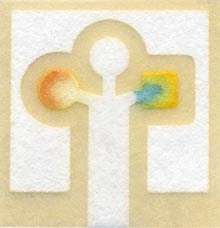February 26, 2010 report
Paper medical lab the size of a fingerprint (w/ Video)

(PhysOrg.com) -- A Harvard University chemistry professor is aiming to produce a blood analyzer for the developing world that will be the size of a human fingerprint, and will cost around a penny.
Professor George Whitesides has already developed a prototype for the technology, which will test blood for diseases common in the developing world, such as HIV, malaria, hepatitis, gastroenteritis and tuberculosis.
The analyzer is a small paper chip with a tree shape printed on it with water-repellant ink of the type used for comic books. Whitesides said the ink saturates several layers of paper and funnels the blood into the channels where it comes into contact with several layers of treated diagnostic paper. Patients place a drop of blood on one side of the paper and the other side displays a colored pattern that indicates to medical professionals if the patient has particular diseases.
Whitesides said the device is similar to a home pregnancy test, but the chips are much smaller and less expensive, and they can analyze the blood for multiple diseases. They also indicate the severity of the infection and not just its presence or absence.
The chips are expected to work in conjunction with mobile phones, which are increasingly popular in developing countries, even in some of the poorest areas. The idea is that people would analyze their blood locally and then send photos of the chips to diagnostic centers in the cities, thus saving them a long journey to the city themselves. Whitesides is even working with a mobile phone manufacturer to develop an application that would give patients the test results if no doctors are available. This may prove particularly useful for contagious diseases such as hepatitis C and tuberculosis.

The new paper lab-on-a-chip is not the first of its kind, but it is simpler than previous lab chips, and much cheaper to manufacture. Whitesides said that “if it works, and it’s cheap, it’s good for everybody.” Possible potential problems include mold, which can easily develop in tropical climates, and accessibility to doctors, since a diagnosis alone is little use unless it is coupled with treatment.
Professor Whitesides hopes the device will be available within 12 months or so. He presented his ideas at a recent TED conference.
© 2010 PhysOrg.com



















